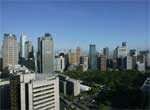The Philippines seems to be avoiding the worst of the global market slowdown, but there have been a few hiccups along the way.
 |
|
The financial Makati district in Manila is not feeling the pinch of the global liquidity crunch. |
While many emerging market economies have suffered during the global market slowdown, the Philippines has been well insulated in a cocoon of decreasing debt, strong growth and increasing interest for both portfolio investors and foreign direct investment. Overall there is little evidence that the global liquidity crunch is having a significant impact on the Philippines, according to Nicholas Bibby, regional economist at Barclays Capital. “The Philippines’ banking sector is flush with liquidity; the loan-to-deposit rate is very low so the banks are not relying on wholesale funding. As a result, it is unlikely that there will be significant transmission through the banking sector going forward,” he says.
In addition, remittances—the most important capital flows into the Philippines—remain strong despite the fact that a large proportion comes from the Filipino population in the United States. Deployment of Filipinos tends to be in areas with labor shortages—such as seafarers and caregivers—and demand for Filipino labor has increased in the Middle East and Asia. Remittances rose 15% year-on-year in the first two months of 2008.
The Philippine economy is also helped by a decreasing budget deficit. “Stripping out the funds coming in from privatizations, the budget deficit is just 1% of GDP,” Bibby notes. “When you consider that it was 4% to 5% of GDP four or five years ago, clearly this is a big improvement.”
The current account surplus has grown, hitting $7 billion last year. Although it may shrink, some believe it will still be strong this year. “We are now looking for GDP growth of 6.5%,” Bibby says. “This may be optimistic but it should come in this side of 6%. Altogether, there are still very positive signs that the global liquidity crunch will have a minimal impact.”
Local liquidity has been largely shielded as it is being managed very closely by Bangko Sentral ng Pilipinas (BSP), the central bank. BSP is mopping up liquidity either with swaps or SDAs (special deposit accounts) and has the flexibility to provide liquidity by loosening policy as needed.
The greatest concern is inflation. Headline inflation hit 6.4% in March, up from 5.4% in February—and up sharply from 2.2% in March last year. The central bank is keen to show it is on top of the situation, and in a recent release stated: “The predominant policy concern of the BSP is to safeguard price stability, so that the ongoing economic expansion can be sustained. It will therefore be keenly on the lookout for factors that could spark inflation. As such, it will closely monitor price and economic developments, both domestic and global, and respond as warranted. It will also continue to provide strong support for non-monetary measures that are necessary to mitigate pressures from the supply side.”
Equity Feels the Squeeze
The global slowdown has been felt most severely in the equity markets. The year began quite solidly with the Philippines Stock Exchange index (PSEi) finally breaking the 3,000-point mark, but the PSEi has since dropped 15%. According to one banker, this has more to do with the investors themselves than Philippine corporate weakening. He explains: “We put together an analysis of shares that have gone down the most over the last five months, and many were for offshore deals raised over the last 12 to 18 months and held by global hedge funds and private equity firms. With the US impact, many had to sell what was sellable—and so the Philippines’ stock market has suffered. But that has little to do with corporate profitability in the Philippines.”
On the debt capital markets side, sovereign rating strength is quite sound, and some landmark transactions for Filipino issuers came out last year, including the $100 million hybrid tier-one perpetual bond transaction for Rizal Commercial Banking (RCBC). The deal, on which Credit Suisse and Citi were lead bookrunners, is callable after 10 years. State-owned LandBank is in discussions to launch a similar hybrid transaction this year.
In addition, last year SM Investments launched the first convertible deal in 11 years to come out of the Philippines. The $270 million deal, through bookrunners Citi and Macquarie, was upped from $200 million on strong demand. At least two more convertibles are expected to come out this year once the markets settle.
“In terms of the local debt market, there are still some challenges that need to be addressed to take the market forward,” says Sanjiv Vohra, Citi’s country officer for the Philippines. One challenge is that the investor base is narrow. The Philippines offers tax advantages for private placements involving 19 investors or fewer, so most bonds get placed privately and are not traded frequently. As a result, liquidity is lacking.”
One area that could also hold promise of growth for the Philippines is real estate investment trusts (REITs). REIT legislation is expected to pass later this year. “Real estate is a big market here,” observes Vohra. “In the capital markets—and on the equity side especially—probably 60% of the market is real estate related, so the REIT would be a very attractive product for the Philippines.”
 |
|
Vohra: REIT is an attractive product. |
Foreign Interest Grows
With the need to raise revenues over the long term in order to continue to pay down debt and maintain growth figures, the government under president Gloria Macapagal-Arroyo has been aggressive in efforts to attract foreign direct investment through privatization of state-held assets. However much has been put on hold as a result of the global slowdown.
“The IPO market has dried up, and we have seen no movement year-to-date in that area,” says Terrence Gray, managing director and portfolio manager for the DWS Emerging Markets Equity Fund. “We do expect some assets to come up for sale in the second half of the year, but that will depend on how the markets are looking and the comfort level of the government,” he adds.
In terms of FDI the big areas of interest are power and infrastructure, property, mining and the service sector through business process outsourcing (BPO). Gray says that people sometimes forget about the mining assets in the Philippines, but they are becoming of greater interest for foreign investors.
Although the Philippines has been the last property market in Asia to recover, and property prices are still much lower than in other parts of Asia, there is growth happening on both the residential and commercial sides. “We saw tremendous demand for power assets and a number of international players coming in,” Vohra says. “Also the power situation is pretty balanced in the Philippines so investors have strong confidence that they will be able to off-lay power into the grid.”
 |
|
Bibby: Infrastructure needs investment. |
Most of the power assets are in the Luzon area, which is the highly attractive consumption belt. “Finally, the ability to put up greenfield power plants has been constrained by commodity prices and equipment supplies that are extremely difficult to source with long lead times,” says Vohra. “As a result, we saw good prices for power assets in the Philippines.”
The IPO of beverage company San Miguel Brewery is under way—after being put on hold as a result of poor market conditions—and everyone is watching for the generation facilities of National Power Corporation. A 40% stake in PNOC Energy Development Corporation (PNOC-EDC) is also on the block. But notes Gray, “Clearly everyone is quite nervous about the global economy, and people are holding off to see how things change.” The government is more aware than ever before of the importance of market timing and is watching for the best opportunity to put assets up for sale.
The Philippines has one of the most open economies in Asia, according to Gray. “The government is really trying to promote foreign investment and has tried to be more aggressive on the privatization front,” he says. “We saw some record deals last year as a result. The country is open for business and wants to attract multinational talent to help grow the service industry, power industry and the property space.”
Aside from inflation, the numerous political rallies held recently—calling for the resignation of President Arroyo after allegations of anomalies in the abandoned broadband deal between ZTE and NBN—are damping investor confidence. But as one economist points out, political rallies are par for the course in the Philippines. He observes: “These are small rallies with less than 10,000 people turning up. If they got beyond 50,000 or if the church were to turn on the government, then it would start to be a concern. But as it is, this is not really a big deal.”
 |
|
Gray: The Philippines is openfor business. |
Over the past few years the Arroyo-led government has demonstrated a strong will to make change. With a serious crackdown on corruption and the implementation of legal-system alterations to address the issue, the current government has shown that it wants the rule of law to matter. In addition, it has focused on cutting bureaucracy to make it easier for investors to invest in the country.
“The infrastructure needs investment, so a lot is tied to government reforms,” explains Bibby. “The key question is whether they can boost tax revenues on a sustained basis. If that happens, then they will have the income they need to invest in infrastructure and maintain the development that they have seen recently.”
The economy is in a sweet spot at the moment, according to Bibby. “We have seen improvement coming through over the past four or five years, and the Philippines has really come back on the radar of portfolio investors and international investors,” he says, “but it is a work in progress.”
Denise Bedell



